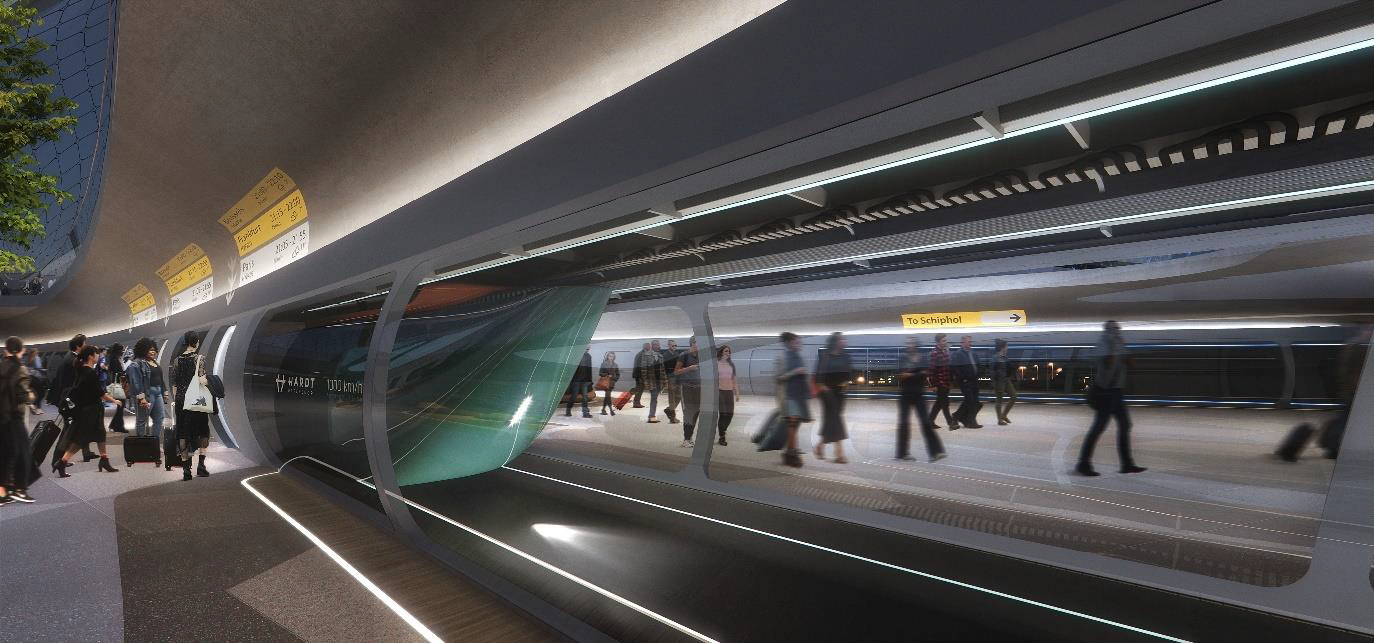A vision for the European hyperloop network
The report, reviewed in this section, titled Hyperconnected Europe by the Hyperloop Development Program and Hardt Hyperloop puts forth hyperloop technology as a viable replacement for conventional transportation. It highlights its eco-friendly and adaptable attributes which are capable of addressing the rising demand in both passenger and freight transportation.

Predicted to require a €981B investment, the proposed European Hyperloop Network can notably alleviate transport challenges. With the capacity to serve 1.3 billion passengers and move 625 million tonnes of freight annually by 2050, this network promises a profound transformation of our transportation landscape.
A major shift from traditional transportation modes is foreseen as a result of this new network. Specifically, the report indicates a 66% reduction in air travel kilometers and an 18% decrease in long-haul trucking, opening the door to more sustainable and efficient transport solutions.
Adopting the Hyperloop Network aligns with the European Green Deal's objectives, as it is expected to cause a significant drop in annual CO2 emissions. The report suggests a potential reduction of 113 to 242 million tonnes of CO2 by 2050, emphasizing the environmental benefits of this novel transportation system.
Although the initial €981B investment is significant, the broad economic benefits of the hyperloop system paint a promising picture for the European economic landscape. The report projects annual returns between €192B and €294B, reinforcing the view that this investment can drive a comprehensive overhaul of Europe's economic environment.
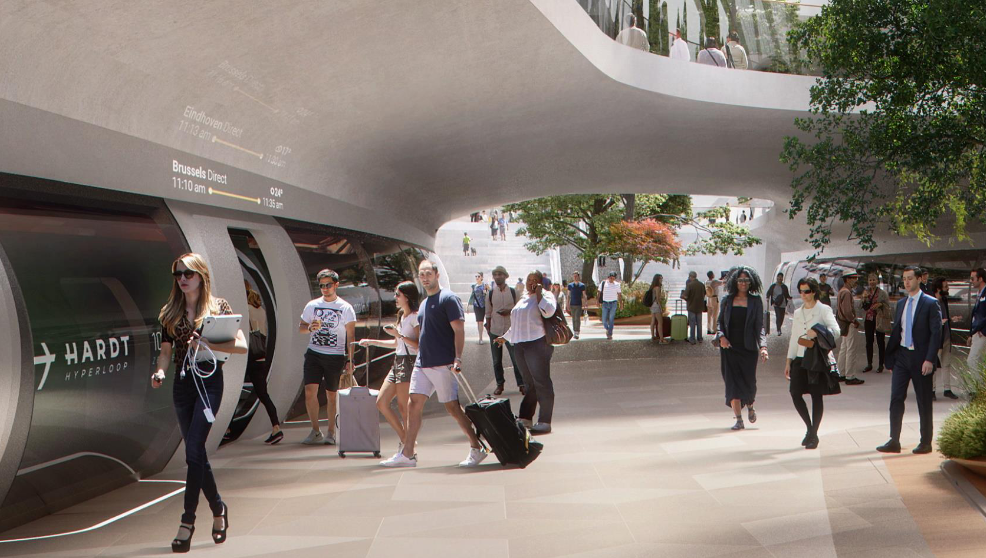
Hyperloop and European transportation challenges
The European transportation system is facing multiple challenges like urbanization, environmental degradation, resource scarcity, consumerism growth, and rising inequality. Even with the impact of COVID-19, the demand for transportation is projected to significantly increase by 2050. Existing transportation methods for passengers and freight are reaching capacity, with private vehicles accounting for a significant percentage of travel and traffic congestion being a persistent issue.
Furthermore, supply chain issues in the freight industry are being aggravated by disruptions in trade flows and geopolitical conflicts. Governments are finding it difficult to implement large-scale transportation infrastructure due to cost, complexity, and policy hurdles.
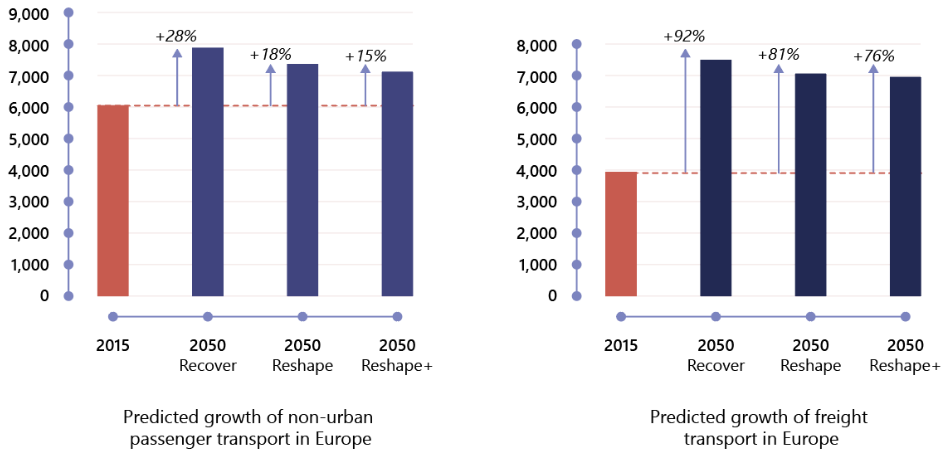
To meet these challenges and the growth in transportation demand displayed in the figure above, over €10T in investments in existing transportation modes will be needed within Europe by 2050. In the midst of this scenario, hyperloop technology emerges as a potential solution.
The hyperloop, an innovative transportation system, is designed for high-speed, energy-efficient transit. Vehicles are propelled at speeds exceeding 700 km/h through a network of low-pressure tubes. Fully autonomous, the system uses magnetic forces and vacuum pumps for guidance and propulsion. A key feature is its high-speed switching mechanism, which allows vehicles to effortlessly change tubes at high speeds, thus mitigating bottlenecks and service disruptions.
With the right policy and regulatory framework in place, the hyperloop could significantly reduce reliance on private vehicles and trucks, provide an alternative to short-haul flights, and supplement high-speed rail systems. In doing so, it aligns with broader environmental and sustainable development goals, offering a promising path to tackle Europe's transportation challenges.

Why hyperloop for passengers?
Hyperloop holds the promise to support the policy agenda driving multimodal decision-making across Europe. It offers potential solutions for reducing long-distance truck transport, substituting short-haul flights and supporting sustainable transportation options like walking, cycling, and public transportation within the context of the European Green Deal. An emerging policy thrust towards banning short-haul flights in favor of greener alternatives opens up opportunities for hyperloop to provide a zero-emission substitute.
The Passenger Working Group of the Hyperloop Development Program has defined the initial set of passenger services that hyperloop aims to offer. These characteristics are shown in the following table:
Service | Characteristic | Service Requirement Operational Parameter |
Capacity | High-capacity tubes, with a throughput
that is comparable to mass transit on
core corridors. | Core corridor capacity > 20,000 passengers per hour, per direction, including passengers with restricted mobility (PRMs), and the possibility of platooning. |
Convenience | Frequent departure and arrivals, with
easy or few transfers, and a short access
and egress time. | Vehicles feature multiple large doors at both sides for quick embarking and disembarking. |
Reliability and punctuality | On-time-running to be higher than current rail and aviation services. | A fully enclosed operating system immune to weather and level crossings. A fully automated system reduces human error. |
Low journey time | Low access, in-vehicle, transfer and egress travel times, egress times, as well as low last-mile travel times. | The combination of fast and seamless travel components makes hyperloop suited to trips of up to 2,500 kilometers in length. |
Vehicle facilities | Features include PRM facilities, passenger seatbelts, and lavatory access. | PRMs can embark and disembark on their own during normal and emergency operations. Seatbelts and lavatories are present in every vehicle. |
The hyperloop passenger experience is crafted around several touchpoints based on the initial set of passenger services displayed above, these are all designed to work together for a seamless journey.
First of all, hyperloop aims to greatly improve passenger experience with various strategies. Flexible ticketing, offering both reserved seating like commercial flights and subscription for "on-the-fly" boarding like public transport, enhances convenience. Easy access to hubs located close to city centers and major interchanges, as well as some outside the city, saves journey time and offers better convenience.
To further improve convenience and journey time, passengers will be able to undergo identification, ticket, and security checks all at walking pace without needing to stop. Quick and efficient embarking and disembarking similar to rail services, made possible by small vehicles with large doors, will reduce total journey time and boost service frequencies, improving reliability, punctuality, and journey time.
Furthermore, the hyperloop system aims to deliver a transportation experience that parallels the convenience and efficiency of rail or metro, while adding the remarkable speed akin to air travel between origin and destination hubs to unlock major travel time savings. Finally, the system is designed for seamless transfers to other modes of transportation at city centers or for the last mile, adding to the convenience of the journey.
The following illustration compares travel times across various distances for different modes of transport, with hyperloop distinctly marked in blue.
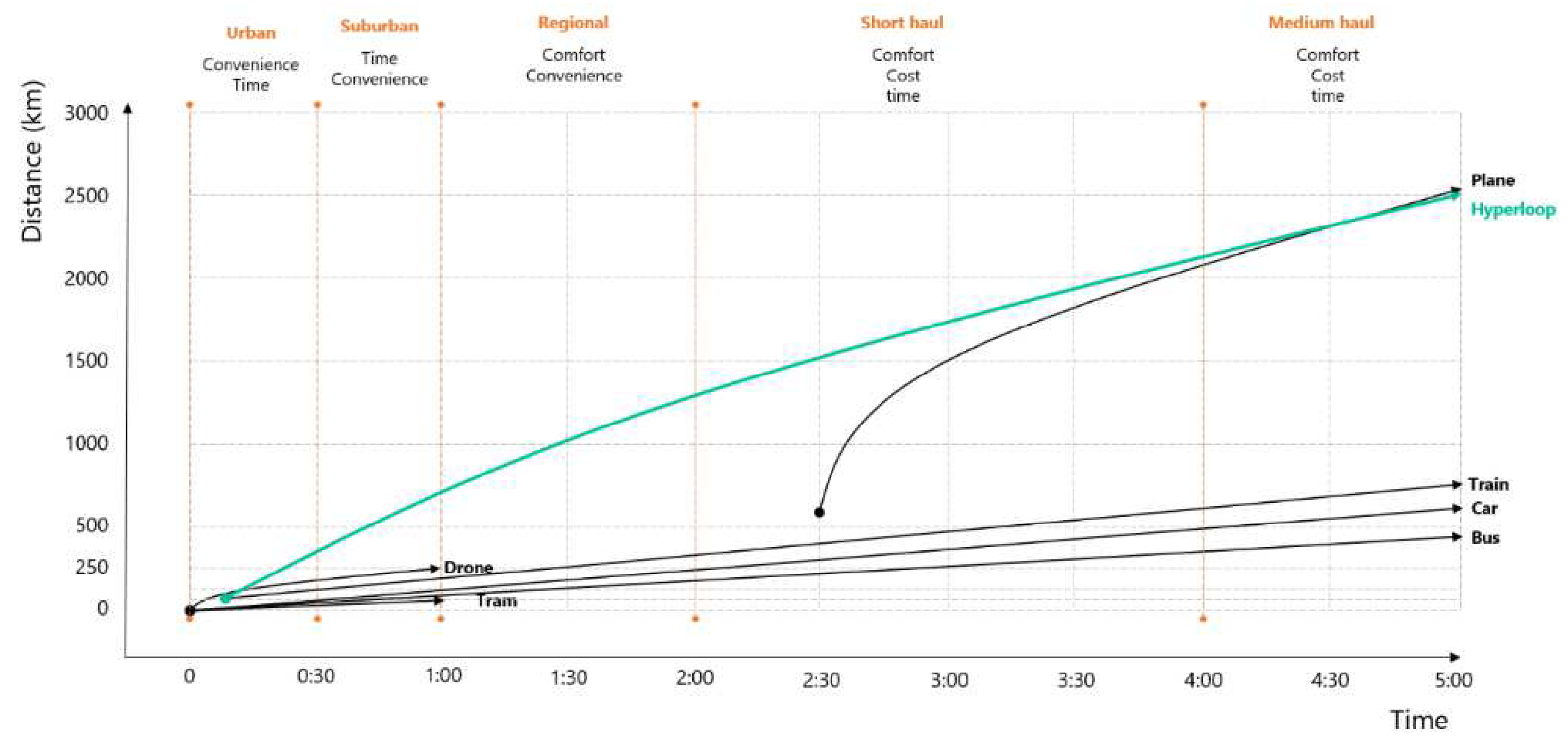
How can hyperloop transform freight?
As Europe grapples with significant challenges in the freight industry – surging emissions, a shortage of drivers, increasing congestion, disruptions in supply chains, and a spike in e-commerce sales – it becomes imperative to reevaluate the European Union’s (EU) Trans-European Transport (TEN-T) policy. This policy is designed to boost productivity by considering alternatives to truck-based transport, such as rail and inland shipping.
Hyperloop steps in as an innovative solution, supplementing the existing mobility network. It provides an eco-friendly, energy-efficient logistic solution that guarantees speedy, regular, and prompt distribution of goods. It is particularly fitting for transporting time-sensitive and high-value goods like fresh produce, pharmaceuticals, electronics, and high-end consumer products that require rapid and reliable transportation services.
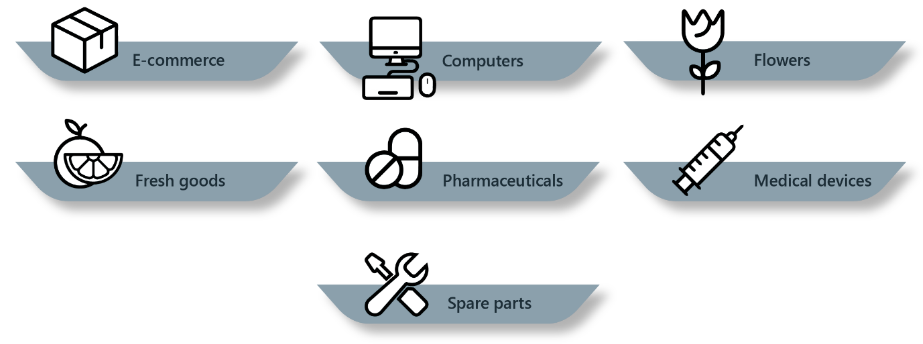
Hyperloop's functional infrastructure disrupts the freight industry. Its freight hubs, seamlessly integrating with existing logistic processes, offer primary loading, unloading, and staging services. For more intricate logistic needs, these hubs provide additional value-added services such as container de-stuffing, palletizing, and sorting operations.
Projecting freight demand is integral to hyperloop's successful implementation. It is predicted that goods that are time-sensitive, high-value, and e-commerce orders are more likely to shift from trucks to hyperloop. Hyperloop freight demand forecasts specifically consider long-haul truck trips exceeding 300 kilometers – the minimum for "day-return" services.
The effectiveness of hyperloop hinges on the strategic placement of its freight hubs. By locating these hubs within supply and demand centers or distribution centers on a city’s outskirts, hyperloop can reduce inbound truck movements. Simultaneously, it can enable last-mile deliveries through lighter vehicles, like courier vans, ensuring efficient, timely, and reliable service (as shown in the picture below).

Route Alignment
A European hyperloop network, aptly named Hyperconnected Europe, is supposed to align with the European Commission's TEN-T network goals. This network aims to integrate all significant cities, airports, and maritime locations into a single, day-return service network, thereby eliminating operational barriers and reducing connectivity gaps in Europe's transportation infrastructure.
The image below illustrates the proposed European hyperloop network, as presented in the Hyperconnected Europe report. The network features both core and regional hubs, and is integrated with existing rail routes between cities, highlighting the synergy between these transportation systems.
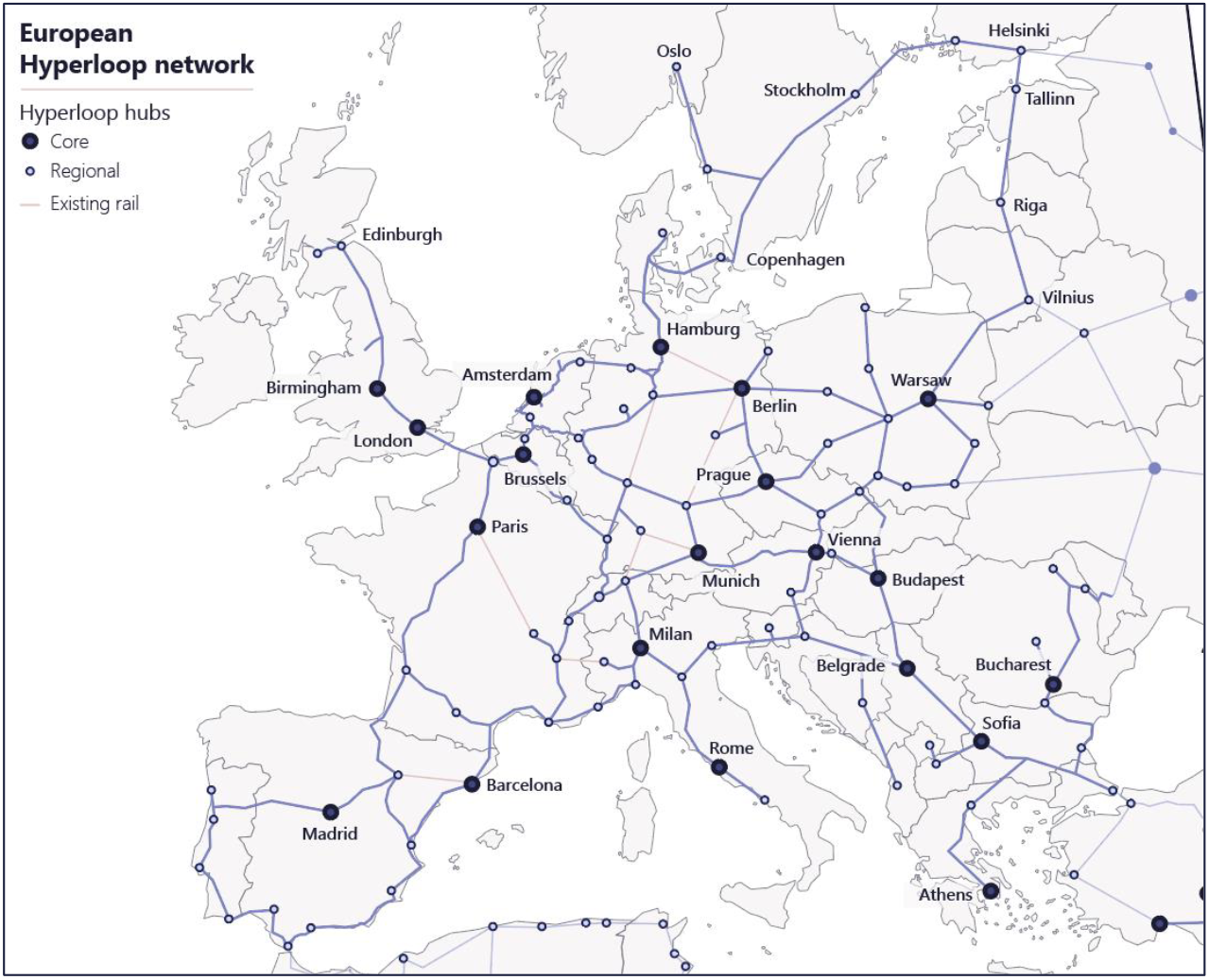
Central Europe, encompassing countries such as Germany, Austria, and Switzerland, is seen as a vital part of the network due to its position at the intersection of multiple TEN-T corridors. It would allow for seamless travel through Europe, and enhance connectivity in highly urbanized areas with significant gross domestic product. Southeastern Europe, including countries like Greece, Romania, and Bulgaria, is also significant due to its potential role in connecting Europe to Asia, potentially carrying large volumes of passengers and freight.
A vital part of the network is its integration into urban settings. Design principles focus on reducing the footprint of hyperloop's infrastructure and introducing innovative servicing methods for cities. Hyperloop's core corridor can either directly connect to the city center or bypass it, reducing conflicts in dense urban areas and improving cost-effectiveness.
The network could profoundly influence urban planning and place-making in Europe. It offers the prospect of drastically shorter travel times between key cities and regions, such as Amsterdam to Groningen in 27 minutes, and Groningen to Munich in just over 2 hours. These plans are anticipated to develop over time and will be continually refined in collaboration with stakeholders.
The Hyperconnected Europe initiative is striving to expedite the integration of hyperloop technology into the transportation landscape by partnering up with different actors.
A summary of the essential features of the Hyperconnected Europe initiative is displayed below.
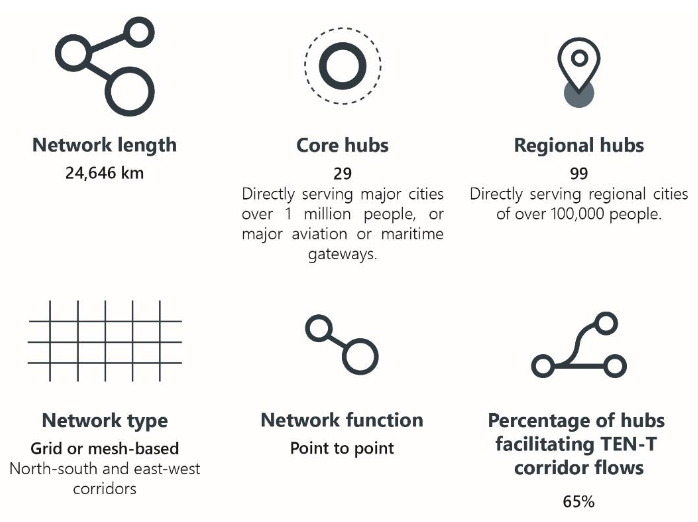
(For a more comprehensive understanding of the integration within urban areas, see the report linked at the end of this page.)
Impact
The European Hyperloop Network is primed to dramatically change how people and goods traverse European cities, leading to significant improvements in livability and competitiveness. By optimizing public transportation networks, hyperloop can diminish car dependency, enhance city-to-city connectivity, and distribute wealth more equitably across the EU. It is set to improve competitiveness through the establishment of seamless cross-border connections, facilitating easy movement of both business and leisure travelers across the continent and smooth transportation of goods throughout Europe.
Hyperloop has the potential to foster socioeconomic cohesion and strengthen the European identity, contributing to a more integrated EU. This aspect is key in promoting mutual understanding and combating societal polarization. Despite the significant capital costs associated with the establishment of a full hyperloop network, the transformative benefits for individuals, businesses, and policymakers across Europe are undeniable. These benefits span time savings, punctuality, reliability, comfort, economic and social benefits, land use and sustainability benefits, as well as safety.
Hyperloop for passenger transport
Shifting focus to the future of transportation, hyperloop technology's anticipated rapid evolution could see a fully established network as early as the 2050s. This swift development, depicted in the visualization below, suggests transformative changes on the horizon for passenger transit.
Taking a look at the graph below on the left, a significant increase in hyperloop usage is expected within the European Hyperloop Network. Annual passenger trips could reach an impressive 1.32 billion, with passenger kilometers potentially hitting 1.31 trillion by 2050. This projection rests on the hypothesis of a 66% modal shift from air to hyperloop travel, an estimate informed by International Air Transport Association's (IATA) 2019 data and a projected 2.7% annual increase in aviation demand through 2050.
However, the right-hand graph informs us that the traveler's choice between hyperloop and aviation is largely distance-dependent. Up to 2,500 km, hyperloop is the preferred mode of transport. Beyond that, aviation becomes the more likely choice. For the European Hyperloop Network, with most distances falling below 2,500 km, this presents a significant opportunity.

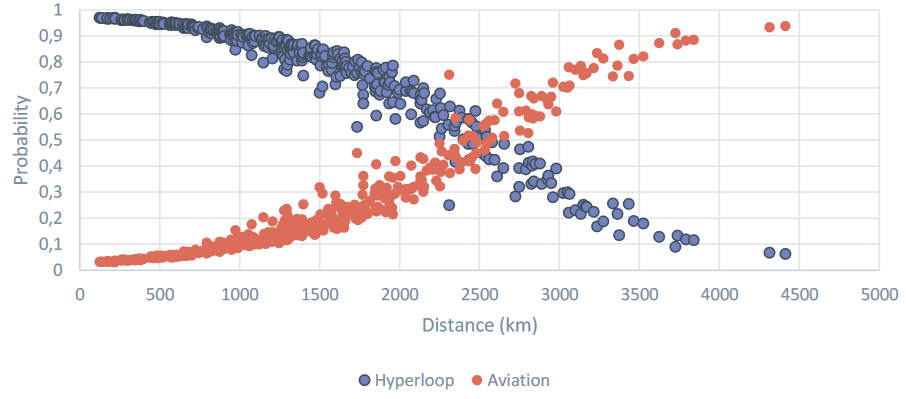
It's crucial to note, however, that these projections are preliminary. More accurate forecasts could be achieved through additional scenario testing and refinement of the current model. Moreover, exploring further scenarios would shed light on hyperloop's potential roles within the broader transportation landscape, such as assessing its capacity to support or stimulate growth within metropolitan or regional transport networks.
Hyperloop for freight transport
The volume of goods transported by hyperloop is expected to depend on the nature and time sensitivity of the goods. Goods that are time-sensitive, high-value, or ordered via e-commerce are expected to shift from trucks to hyperloop.
The calculation of hyperloop's potential for freight carriage below only includes long-haul truck trips exceeding 300 kilometers, deemed as the baseline for "day-return" services. Projections indicate that hyperloop could potentially reduce these long-haul truck movements within the EU by 19% and overall truck operations by approximately 6% by 2050.
While these estimates are preliminary, further strategic adjustments could drive down long-haul truck operations even more. The efficiency of hyperloop transportation is closely linked to the strategic placement of its freight hubs. By situating these hubs in supply and demand hotspots, or on the outskirts of cities, hyperloop could cut down on incoming truck traffic, while supporting last-mile deliveries through lighter vehicles.
As per projections drawn from 2019 Eurostat data, by 2050, hyperloop could potentially carry 625 million tonnes or 389 billion tonne-kilometers of freight. The graph below visually represents these anticipated figures.

Impact for existing modes of transport
The establishment of a full hyperloop network by 2060 will inevitably impact the share of existing transportation services. Hyperconnected Europe's mode share research suggests significant implications. For aviation, passenger kilometers traveled may decline by around 70 percent for intra-European flights. For rail, no modal shift between rail and hyperloop is anticipated. However, rail and hyperloop could collaborate by shifting passengers from rail to hyperloop, freeing up capacity for containerized or inter modal freight transportation on rail, thus improving the overall shift from road to more sustainable modes. Similarly, the introduction of hyperloop could increase the overall number of passengers opting for public transport, where rail could serve as a feeder to the hyperloop network, increasing the modal share of rail for passengers. As for on-road transport, a shift from long-distance truck transportation is envisaged, potentially reducing pressure on the roads.
Benefits from hyperloop are vast, spanning transport, economic, social, land use, sustainability, and safety sectors. These benefits include travel time savings, punctuality, reliability, comfort, job creation, economic clustering, commuter trips induced by hyperloop services, congestion relief, socioeconomic integration, mode shift from cars, trucks, and flights towards active and public transport, urban densification, city shaping, urban regeneration, mixed-use planning opportunities, greenhouse gas emissions reduction, reduction in vehicle kilometers traveled for cars or trucks, reduction in noise emissions, and reduced road accidents.
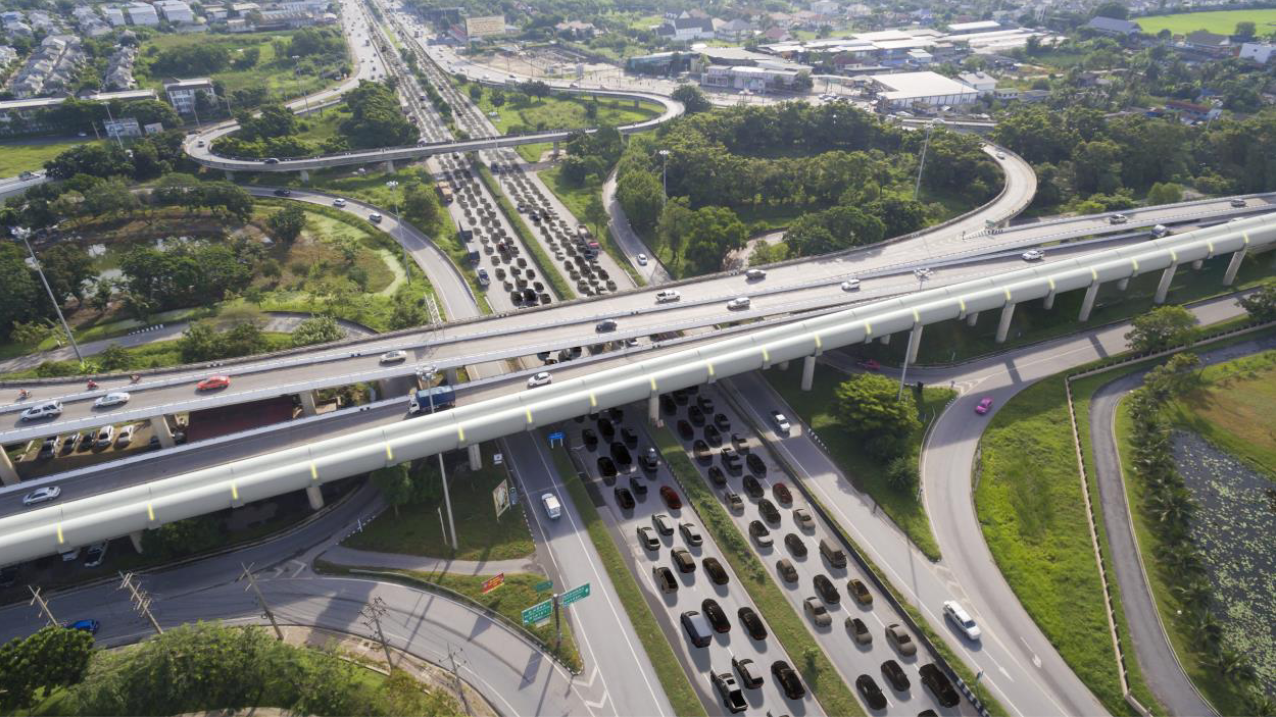
Financial costs and benefits
While the establishment of the European Hyperloop Network by 2050 will require considerable investment, it is critical to view this investment in light of its vast potential return. The capital expenditure necessary for creating this comprehensive network is estimated at €981B (in 2022 values). While this is substantial, it paves the way for the transformative benefits associated with a broad and integrated European Hyperloop network, covering everything from transportation and economic to social, land use, and sustainability benefits.
The annual operational expenditure by 2050 is forecasted at €48.1B. The application of magnetic levitation technology and fully autonomous operations within a protected environment help to keep these operational costs under control, ensuring a highly efficient transportation system.
On the revenue side, the annual turnover for the hyperloop network by 2050 is projected to be a robust €248.4B. This total includes €50.6B from freight services and €197.8B from passenger services. It is worth noting that the price per tonne-km for freight transportation via hyperloop is designed to be competitive with the average price charged for trucking across Europe. For passengers, the price per passenger-km is set to be competitive with existing modes of transportation.
Beyond these direct financial figures, the wider economic benefits the hyperloop network can generate are between €192B and €294B annually. This range accounts for the positive impacts on transport, economy, society, land use, sustainability, and safety. Therefore, despite the sizable initial capital outlay, the European Hyperloop Network could yield a significant return of benefits by 2050, greatly outweighing the investment cost.
In essence, while the initial financial commitment is significant, the benefits of the hyperloop system – both direct and indirect – have the potential to transform the economic landscape of Europe. The investment into the hyperloop network is not just a cost, but an investment into a future of efficient, sustainable, and rapid transportation. The financial promise of the hyperloop system is clear: it is a forward-looking investment that is set to pay off impressively in the long term.
The impact on European Cities
According to the EU’s Joint Research Centre, the face of European cities will transform significantly in the future. Expected changes include urban expansion with a focus on spatial organization, an aging, wealthier, and more mobile population, increasing technological integration with associated social risks, a shift from car dominance to efficient public transport, affordable housing provision, and increasing urban density with sustainable, self-contained neighborhoods.
Hyperloop can address these urban challenges by fostering sustainable and inclusive growth, reducing car dependency, and enabling a more equitable distribution of wealth across the EU. The figure below shows how hyperloop could aid in combating the different challenges.
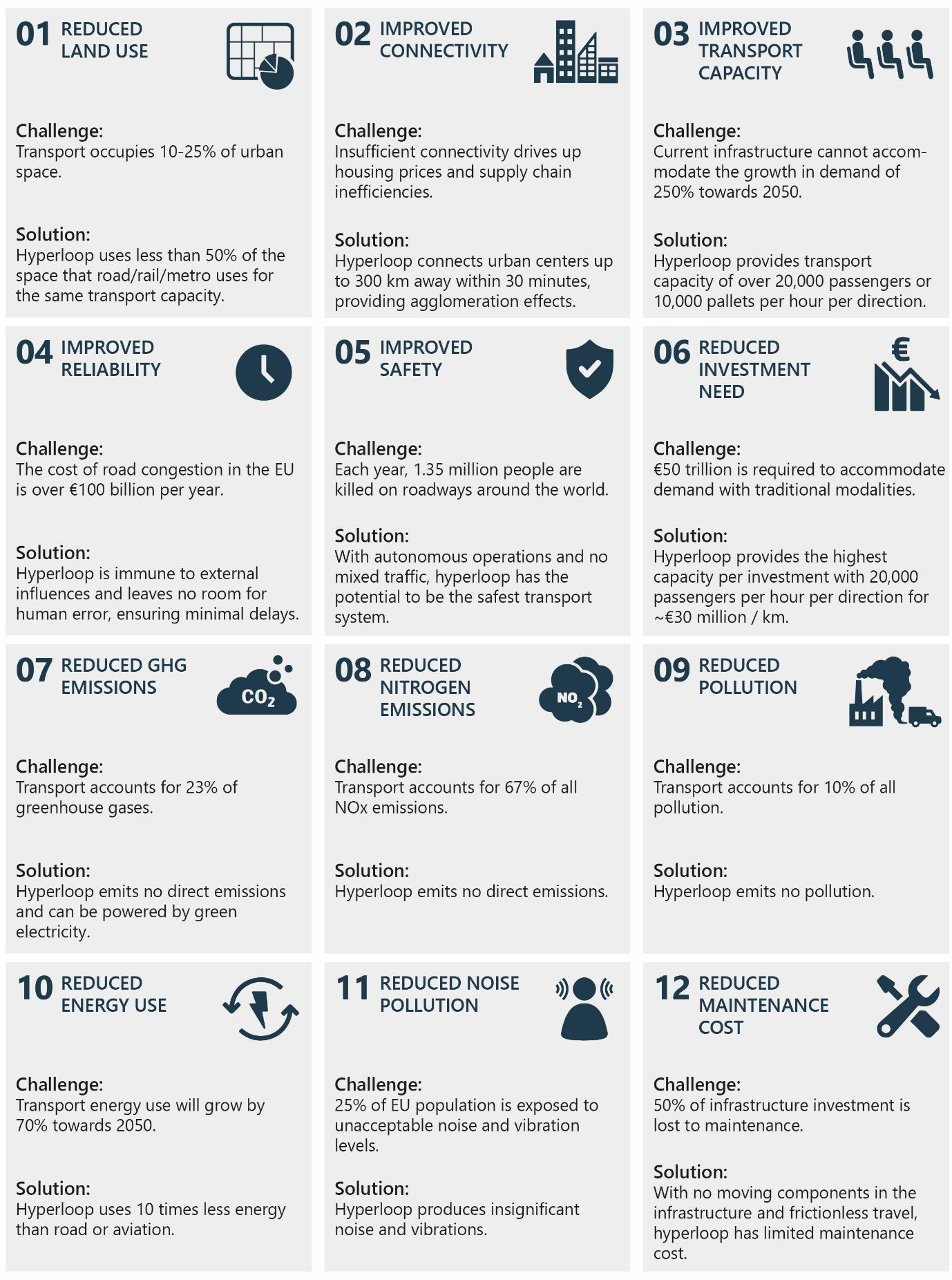
The decline in Europe's competitiveness could be addressed by leveraging hyperloop technology to boost connectivity between cities. This could create an eco-friendly urban network, effectively transforming the EU into a unified, expansive metropolis. With hyperloop enabling effortless and sustainable cross-border travel and efficient goods movement, the single market could be completed. This improved integration, fostered by hyperloop, could not only enhance trade and travel but also promote socioeconomic cohesion and a strengthened European identity.
Project Realization
Hyperloop technology is rapidly progressing and has the potential to revolutionize transportation in Europe. The Hyperloop Development Program is building the European Hyperloop Center in Groningen, with the first tests slated to start from late 2023 (see figure below for timeline). Pilot routes are being assessed across Europe, with the first routes expected to be implemented over short distances from the second half of the 2020s. By the 2030s, hyperloop networks for freight and passengers will be extended, creating regional networks across Europe, and eventually forming one pan-European network by the 2050s.
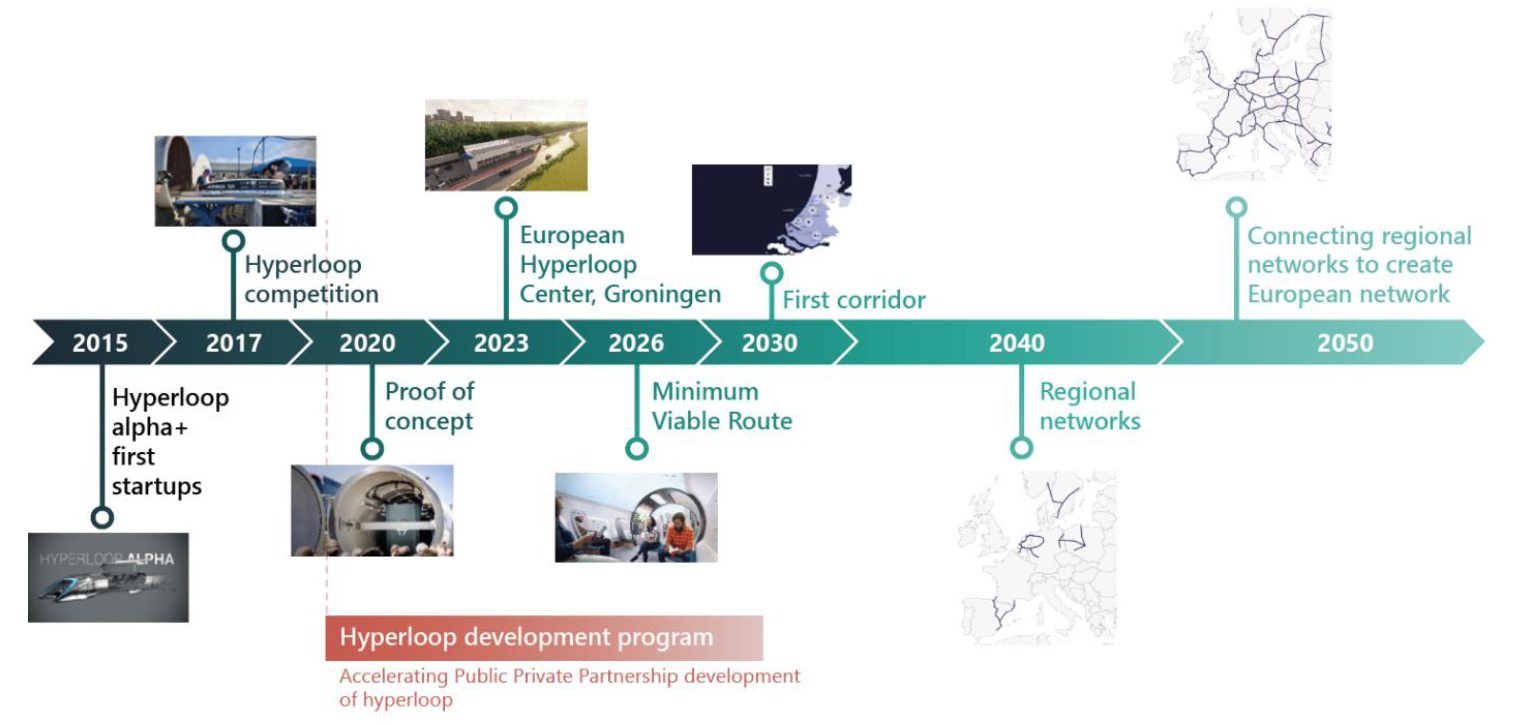
Berenschot Consultants, Hyperloop Development Program partner, state that hyperloop's success hinges on the development of its technological backbone and widespread public acceptance. They suggest starting with freight transportation due to less stringent guidelines and standards. As cities strive for more sustainable and livable urban centers, shifting freight from highways to hyperloop is seen as a promising solution. However, this will require de-investment in legacy systems and significant changes to business processes.
While the hyperloop ecosystem matures with freight services, passenger services can be gradually introduced according to Berenschot Consultants. This transition will necessitate collaborative strategic planning between multiple regions. Also, the integration of hyperloop infrastructure into urban planning is crucial.
To bring this vision to life, local and regional governments should start positioning hyperloop as a viable alternative to conventional transportation modes. This will help achieve the EU's Green Deal goal of climate neutrality by 2050. As the ultimate beneficiaries of hyperloop, cities, regions, and their citizens can push for infrastructure investments as a public good.
Despite multiple hyperloop companies promoting their unique concepts, the consultants stress the importance of developing and adopting universal standards to ensure swift adoption, necessitating pan-European cooperation and coordination.
Participants
As of June 2022, the following city and regional governments have signed the Letter of Support for
Hyperconnected Europe:

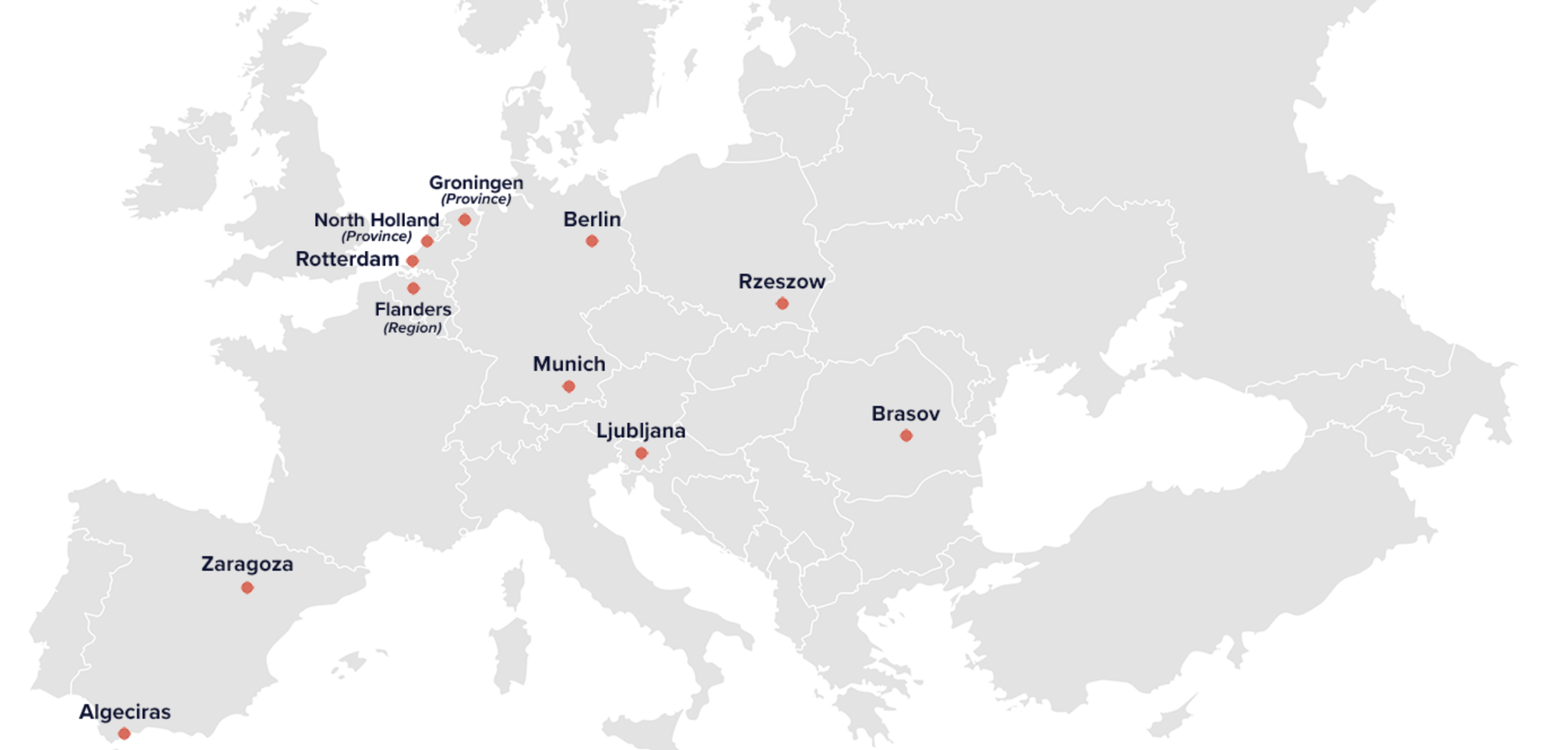
Acknowledgements


hyperloopdevelopmentprogram.com
https://hyperloopdevelopmentprogram.com/wp-content/uploads/2022/07/Hyperconnected-Europe-Phase-1-Report.pdf
